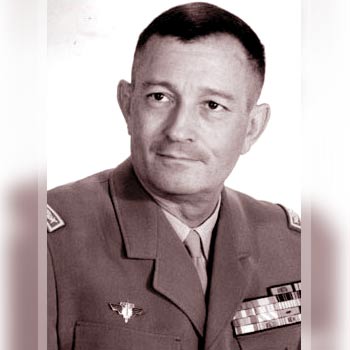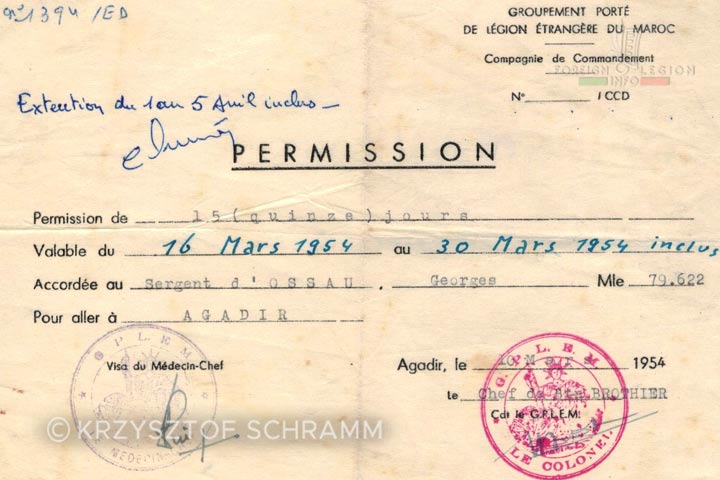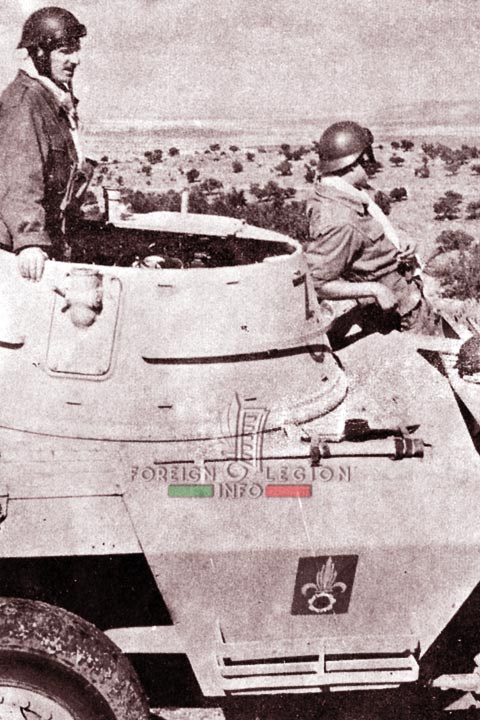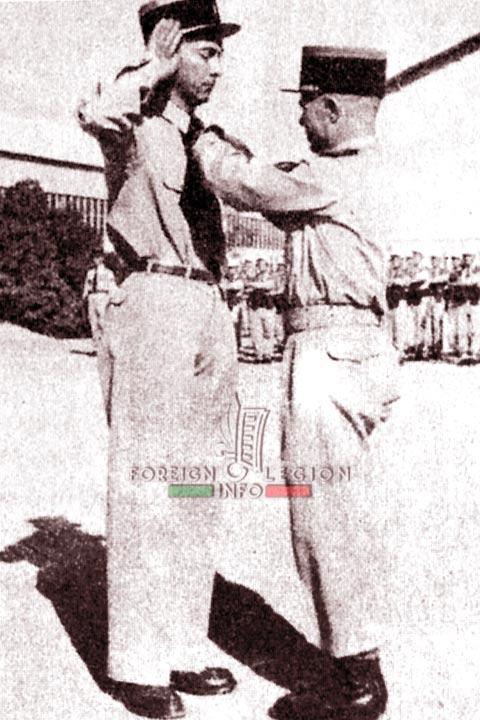The Foreign Legion Moroccan Motorized Group (GPLEM) was a motorized infantry unit serving in Morocco from 1947 to 1956. The group was composed of motorized companies that maintained order in southern Morocco, western Algeria and northern Mauritania. The GPLEM was dissolved in November 1956 and its companies were incorporated into the 4th Foreign Infantry Regiment.
—
La version française de cet article:
GPLEM : Groupement Porté de Légion Etrangère du Maroc
—

The Foreign Legion Moroccan Motorized Group (Groupement Porté de Légion étrangère du Maroc, GPLEM) was created on July 1, 1947, simply by changing the title of its predecessor, the GCPLEM: Foreign Legion Moroccan Motorized Company Group, which had only existed for a short time.
In the French infantry, a groupement porté designated a highly mobile unit whose troops were transported by military light vehicles. In fact, it was a motorized light infantry battalion, consisting of motorized companies – compagnies portées – which were the evolution of the Mounted Companies, compagnies montées.
As a matter of interest, some English-writing authors translate the French term porté as mobile, which is incorrect. In fact, the mounted companies equipped with mules were also considered highly mobile. In French, the literal meaning of monté and porté is the same – carried. So, the main difference in the French military designation is that mounted light infantry troops (montées) are carried by animals, while motorized light infantry troops (portées) are carried by vehicles.
The GPLEM consisted of a small headquarters staff, a command company, and three motorized companies (1re CP, 2e CP, and 3e CP). The group was commanded by Lieutenant Colonel François Binoche, a long-serving Foreign Legion officer. His headquarters was located in Agadir, a town in southwestern Morocco, and a popular seaside resort on the Atlantic coast.
The 1st Motorized Company (Compagnie Portée) of Captain de l’Escapolier was based at the Le Moal post in Foum El Hassan. It had been its garrison since the 1930s, when the then company was still serving there under its original name of Automobile Mounted Company (CMA) of the 4e REI. It was the oldest and furthest south of the group’s companies, located some 110 miles (180 km) south of Agadir.
The 2nd Motorized Company was stationed at the Captain Morel barracks in Taroudant, some 50 miles (80 km) east of Agadir. The town of Taroudant is a real citadel, defended by almost four miles (6 km) of ramparts with 130 towers and 19 bastions.
The 3rd Motorized Company was located in Tiznit. This town, also defended by imposing ramparts, lies some 50 miles south of Agadir.
The command HQ of the GPLEM and its services were in Agadir, at Camp Sigmann and Camp Alibert.
From a territorial point of view, the Motorized Group was assigned to the autonomous Agadir-Borderlands Subdivision (SAC), which at the time included not only southern Morocco, but also the Algerian region of Tindouf and the northern part of Mauritania in what was then French West Africa. This tradition dates back to 1934, at the end of the pacification of this territory by troops coming from southern Morocco, including legionnaires. As a highly mobile unit with a wide range of action, the GPLEM maintained regular contact with these Saharan regions, which were an integral part of the unit’s area of operations.
The reason why this group existed in Morocco is simple. Morocco had been a French protectorate since 1912, as part of French North Africa. The Legion was present there from the very beginning of French military operations (1907) and played an important role in the pacification of the country (completed in 1934). However, the Second World War caused the exodus of the vast majority of legionnaires. By 1944, only four grossly undermanned companies remained in Morocco out of the original three infantry regiments that had still served there in 1940. Incorporated into a single group, these companies continued to maintain the presence and glory of the Legion in the country.
Reduced to only three in 1946, the companies of the group had, of course, a number of other tasks as well. These included maintaining law and order in the territory, maintenance and building of roads, maintaining liaison with other military posts and services in their assigned sectors, helping military or civil motorists in difficulty in desert areas, and serving as the Subdivision’s intervention forces. It was also necessary to provide basic training to young legionnaires coming from Algeria before their deployment to the Far East (to take part in the First Indochina War, 1946-1954). Lastly, the companies served as transit units and offered an opportunity to rest and recharge for those legionnaires and NCOs who returned to North Africa from their necessary two-year-long tour in Indochina; they served with the GPLEM several months before their new deployment.
In addition to these tasks, the legionnaires carried out military training, exercises and maneuvers, as well as construction work to modernize their posts. To break the monotony of garrison life, there were also some nice Saharan reconnaissances, as well as more difficult forays into Mauritania and as far as northern Sudan (present-day Mali).



The theoretical strength of the GPLEM companies in 1947 was about 230 men. A figure much higher than that of an ordinary infantry company because of the presence of many vehicles and drivers. However, due to the war in Indochina, the number of men soon decreased to about 150, and remained in great fluctuation. The majority of the troops were Germans.
In 1947, each company was composed of a command platoon and three motorized platoons, and had thirty to forty vehicles for transporting troops (generally Dodge 4×4 or British Bedford trucks, right-hand drive, which had been used in the Libyan and Tunisian campaigns in WWII, but also still some French Latil M7T1 4×4 trucks), as well as tankers and Panhard workshop trucks. At the beginning of the 1950s, the companies would have been mostly equipped with Dodge 6×6 trucks.
On November 1, 1950, following the need for men for Indochina, the 1re CP was temporarily transformed into a cadre company (a non-operational, “fictional”, half-dissolved unit), and placed in Agadir. On May 31, 1951, in Tiznit, the 3rd Motorized Company under Captain Robert Lacote was dissolved, also due to the lack of men. The next day, the captain took command of the reactivated 1re CP. He was the best-known officer within the GPLEM; he had served with the group’s companies intermittently since 1944.
GPLEM composition in June 1951:
- Commander: Lieutenant Colonel Raberin
- HQ Staff: Major Périn
- HQ Company: N/A
- 1st CP: Captain Lacote
- 2nd CP: Captain Vadot
In 1954, the group saw its equipment completed in quantity. It was provided with U.S. M8 Light armored cars (called AM-M8 in France) to form an armored platoon within each company. This year also marked the end of the war in Indochina and the beginning of the troubles in North Africa, from which Morocco was not excluded.
During this time, the unit took part in security patrols. It was necessary to show up in several places at once. Therefore, the men had to split up and operate by section, platoon, or detachment. They had to reach even sites where vehicles couldn’t enter, so raids were mostly carried out on foot. The legionnaires of the GPLEM thus demonstrated their presence and their ability to access the most remote areas in the region of Agadir, as well as in the Atlas and Anti-Atlas mountains, relatively quickly. As a Legion brochure of the time states:
“The Legionnaire in 1955 is rediscovering, curious, a Morocco that could not be seen from the road and that his predecessors must have known well. He has resumed contact with it.“
It was necessary to adapt to these new tasks. For this reason, specialized elements were formed within the group in 1955: a Mountain Platoon, a K9-commando, two reconnaissance platoons and, lastly, two commandos (unfortunately, more details about them are not available).
In late 1955, the GPLEM companies – under Captain Bertany (1re CP) and Captain Chamagne (2e CP) – maintained order in the north of the country, in Rabat. At the beginning of 1956, a commando from the group left for Tindouf in Algeria. There they met comrades from the 4e CSPL (Saharan Motorized Company), who were also deployed to the region. Operations in this area were conducted against local insurgents coming from Spanish Morocco.
Nevertheless, the political situation changed considerably. France’s abandonment of the country became a reality. Then in March 1956, Morocco obtained its independence. All missions and operations of the GPLEM were suspended. The units regrouped in Agadir and the legionnaires waited to be repatriated. During this period, they were in charge of maintaining order and defending the security of French nationals in the area. They also ensured vital connections between military headquarters, and escorted high authorities.
Finally, on November 15, 1956, the GPLEM was administratively disbanded. The next day, at Camp Sigmann in Agadir, it became the 2nd Motorized Company Group (GCP 2) of the 4e REI; the latter was transformed into a motorized regiment on the same day. The 1re CP and 2e CP of the former GPLEM then became the 4th and 5th Motorized Companies, respectively, of the freshly reorganized regiment.
In March 1957, while the 4e REI was leaving Morocco for Algeria, the two companies of the ex-GPLEM set off for Mauritania. There, they would take part in operations against the rebels from Spanish Morocco until 1958.
To complete this topic, it should be added that a sister unit of the GPLEM was formed in Algeria in 1956. To learn more, see the Foreign Legion Algerian Motorized Group (GPLEA).


















GPLEM: Commanding Officers
| PERIOD | COMMANDER | |
|---|---|---|
| GPLEM | 1946-1949 | LCL BINOCHE François |
| GPLEM | 1949 | CBA TOKHADZE Nicolas |
| GPLEM | 1949-1951 | LCL LAIMAY Edmond |
| GPLEM | 1951 | LCL RABERIN Jean |
| GPLEM | 1951-1952 | ??? N/A |
| GPLEM | 1952-1953 | LCL TOKHADZE Nicolas |
| GPLEM | 1954-1956 | LCL BROTHIER Albert |
| GPLEM | 1956 | CBA DARMUZAI Pierre |
———

You can support this website at any time through our store. Thank you.
EU-based readers can visit our EU-based shop, to avoid import charges.
—
Main information sources:
Képi blanc magazines (1959, 1961)
Michel Brun: A Foum El Hassan avec la 13e CPLE 1946-1947 (Képi blanc, 1996-1997)
Foreign Legion annual bulletins (1950s)
P. Cart-Tanneur + Tibor Szecsko: Le 4ème Etranger (Editions B.I.P., 1987)
Tibor Szecsko: Le grand livre des insignes de la Légion étrangère (S.I.H.L.E., 1991)
J. Brunon, G.-R. Manue, P. Carles: Le Livre d’Or de la Légion Etrangère (Charles-Lavauzelle, 1976)
Fanion Vert et Rouge
Google.com
Wikipedia.org
———
Other GPLEM images & information (in French):
Camp de la Légion Étrangère-Camp IV-Camp Sigmann
Les souvenirs de la Légion étrangère à Agadir
———
Related articles:
Foreign Legion Algerian Motorized Group
1st Legion Saharan Motorized Company
2nd Legion Saharan Motorized Company
3rd Legion Saharan Motorized Company
4th Legion Saharan Motorized Company
—
The page was updated on: December 04, 2021
